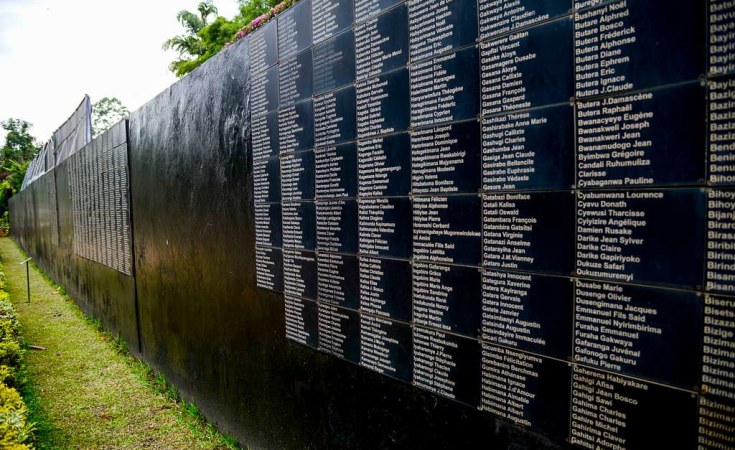As Rwanda commemorates, for the 30th time, the 1994 Genocide against the Tutsi, the country will also honour politicians, who opposed divisive politics and were killed for their convictions during the Genocide in which more than one million innocent lives were lost in 100 days.
They will be specifically honoured on April 13, a day that is dedicated to paying respect to politicians from different political parties who paid the ultimate price for their anti-genocide political convictions.
Nine new names of politicians who denounced genocide ideology through their deeds will have their names inscribed at Rebero Genocide Memorial, which is the resting place of more than 14,400 Genocide victims, including 12 politicians who stood firm up against the genocidal regime.
April 13 also marks the end of the commemoration week, though commemoration activities will continue both within and out of the country up to June 19.
They bravely fought against the genocide in their respective areas and saved Tutsi lives. However, they were killed in horrific ways for their courageous acts of resistance.
Below are their names, their positions, and the dates on which they were killed:
1. Boniface Ngulinzira
Boniface Ngulinzira, the former Minister Foreign Affairs, advocated for Rwandan unity during the Arusha peace talks, which brought together the regime of Juvenal Habyarimana and the then RPF-Inkotanyi rebels.
He saw the peace talks as the viable solution to not only end the war between the then government forces and RPF-Inkotanyi, but also bring an end to the cycle of violence perpetrated by the successive regimes that led the country since independence.
Because of his tolerant political convictions, Ngulinzira in the early 1990s defected from MRND, the extremist ruling party that promoted divisionism and precisely targeting the Tutsi to MDR.
He was dropped from cabinet by Habyarimana in 1993, when he formed the so-called Broad-Based Transitional Government which was supposed to work with RPF and other political parties as per the Arusha accords.
According to a testimony from his daughter, at the beginning of the Genocide against the Tutsi, Ngulinzira was evacuated with his family by UN peacekeepers to their base at the former ETO Kicukiro, only for him to be abandoned with thousands of Tutsis when the same peacekeepers decided to leave the country.
He was killed on April 11, 1994 on the hill of Nyanza in Kicukiro where thousands died after enduring a trek from ETO Kicukiro which has been likened to the journey to Golgotha made by Jesus Christ.
2. Godefroid Ruzindana
Godefroid Ruzindana, the former prefect Kibungo prefecture (which is currently made up of the districts of Ngoma, Kirehe, Rwamagana and Kayonza) stood against genocidal politics and he, together with his family, was killed as a result.
Ruzindana came from the PSD party. He was killed in May 1994. Before he was killed, he was replaced from his position by an extremist Anaclet Rudakubana who immediately rolled out the killing machine that took lives of tens of thousands in Kibungo and surrounding areas.
3. Jean-Groubert Rumiya
Jean-Groubert Rumiya, who was a professor at the former National University of Rwanda, left the MRND, the party of President Juvenal Habyarimana, in November 1992 in opposition to the encouragement of violence against the Tutsi.
His resignation from the extremist party stemmed from the incendiary speech made in 1992 by Leon Mugesera, who was his fellow faculty member at the university, in which he openly called for the extermination of the Tutsi.
Following the speech, Rumiya apparently confronted the regime, asking them to distance themselves from Mugesera's utterances. When they did not and instead chose to endorse it, he resigned from the party, both as a member of the political bureau and as a party member altogether.
Rumiya was killed on May 4, 1994.
4. Vincent Rwabukwisi
Vincent Rwabukwisi was a journalist and politician who used his platform, Kanguka newspaper, to promote peace and reconciliation at a time when violence and discrimination were being encouraged by the media.
He founded Kanguka purposely to counter the extremist and toxic narrative that was being promoted by Kangura newspaper that was edited by now Genocide convict Hassan Ngeze.
Rwabukwisi, who was also the president of UDPR party, was killed on April 11, 1994.
5. Jean-Baptiste Habyarimana
Jean-Baptiste Habyarimana, the former prefect of Butare prefecture (currently covering the districts of Huye, Nyanza and Gisagara) dedicated his political efforts to preventing violence during the Genocide against the Tutsi.
He was a Tutsi. With Habyarimana as the prefect, Tutsi killings were prevented in Butare until he was replaced with a hardliner who encouraged genocide in the prefecture.
Habyarimana was openly denounced by Theodore Sindikubwabo, the president of the genocidal government in a rally at which he officially launched the killings in Butare.
6. Calixte Ndagijimana
Calixte Ndagijimana was the burgomaster of Commune Mugina in the former Gitarama prefecture.
A member of the MDR party, he was one of three burgomasters (mayors) who fought against the genocidal killings in their communes and were killed for their convictions. He was killed on April 21, 1994.
7. Narcisse Nyagasaza
Narcisse Nyagasaza was the burgomaster for Commune Ntyazo also in the former Butare prefecture. He came from the PL party. Like Ndagijimana, Nyagasaza also opposed killings in his commune and he had to pay with his life.
He was killed on 23 April 1994.
8. Jean-Marie Vianney Gisagara
Jean-Marie Vianney Gisagara was the burgomaster of Commune Nyabisindu, also in Butare prefecture. He was a member of the PSD party. Like Ndagijimana and Nyagasaza, Gisagara also opposed the Genocide against the Tutsi. He was killed on May 5, 1994.
9. Dr Theoneste Gafaranga
Theoneste Gafaranga was a private medical practitioner from the PSD party. He was the second vice president of PSD. He was killed on April 16, 1994.


